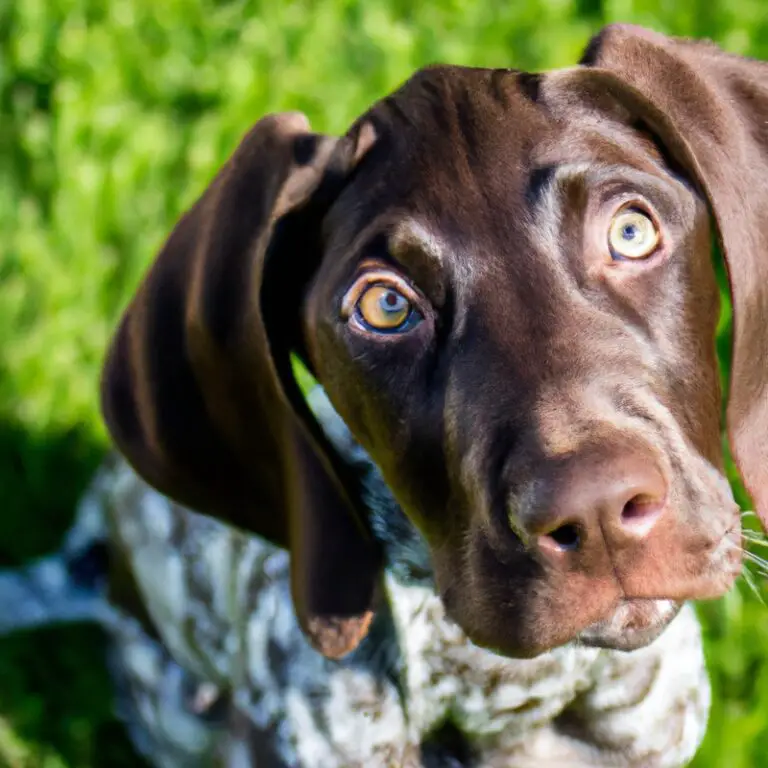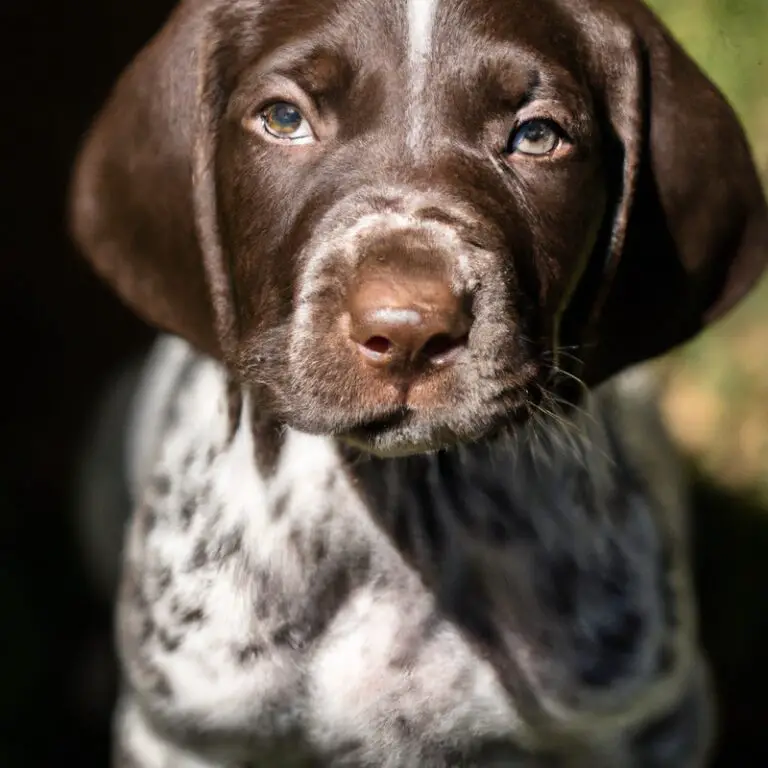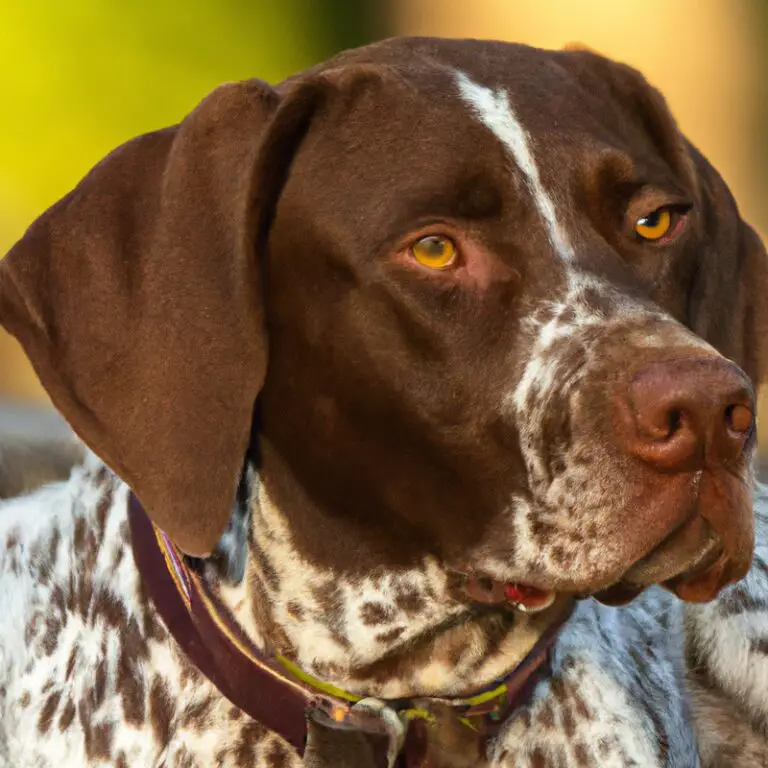How Can I Prevent My German Shorthaired Pointer From Pulling On The Leash?
Key Takeaways:
- Use positive reinforcement training methods to teach loose leash walking.
- Invest in a well-fitted harness to provide better control over your dog’s pulling.
- Ensure your dog gets enough physical and mental exercise to reduce leash pulling behavior.
- Seek professional help if the issue persists or if your dog’s pulling is a safety concern.
Are you tired of feeling like a human kite every time you take your German Shorthaired Pointer for a walk? Trust me, I’ve been there too.
Those strong, energetic dogs seem to have an endless abundance of energy, which often translates into some serious leash pulling.
But fear not! Today, I’m here to share some expert tips that will help you prevent your German Shorthaired Pointer from yanking your arm out of its socket. We’ll dive into the mindset of this breed, establish a strong foundation for leash training, discuss the right equipment to use, and explore techniques to make your walks enjoyable for both you and your furry friend.
So, grab your coffee and settle in, because we’re about to bring some peace and harmony back to your daily walks.
| Method | Advantages | Disadvantages |
|---|---|---|
| 1. Positive reinforcement training | – Creates a positive association with walking on a loose leash – Encourages desired behavior – Builds trust and strengthens the bond between owner and dog | – Requires patience and consistency – May take time for results to show – Not effective for all dogs |
| 2. Use a no-pull harness | – Provides more control over the dog’s movement – Reduces strain on the dog’s neck – Can help redirect pulling behavior | – May need time for the dog to adjust to wearing a harness – Requires proper fitting to be effective – Does not address the underlying behavior |
| 3. Attend obedience classes | – Professional guidance and support – Training in a distraction-free environment – Socialization with other dogs | – Additional cost and time commitment – Results may vary depending on the individual dog and owner’s involvement – Not suitable for all dogs |
| 4. Seek professional help | – Expert assessment and individualized training plan – Addressing specific behavior issues – Faster results with professional guidance | – Higher cost involved – Requires commitment to follow through with recommendations – Results may vary depending on the dog’s temperament and owner’s involvement |
Understanding the behavior of a German Shorthaired Pointer
The energetic nature of German Shorthaired Pointers
German Shorthaired Pointers are known for their high energy levels. They are active, lively, and always ready for action.
This energetic nature is deeply ingrained in their breed, as they were originally bred as hunting dogs.
These dogs have a natural drive to run, explore, and engage both physically and mentally. They thrive on exercise and mental stimulation.
To keep up with their energy levels, it’s essential to provide them with regular physical exercise, such as brisk walks, jogging, or playtime in a secure area.
Mental stimulation, like puzzle toys or obedience training, is also important to keep their minds occupied. German Shorthaired Pointers may become restless or even exhibit destructive behaviors if they don’t get enough exercise or mental stimulation.
They are not well-suited for a sedentary lifestyle and may struggle in apartments or homes without sufficient space to move around.
Understanding their energetic nature is crucial in providing them the right environment and activities to keep them happy and fulfilled. With proper exercise, mental stimulation, and attention to their needs, these energetic dogs can make excellent companions.

The strong prey drive and hunting instinct
The German Shorthaired Pointer is known for its strong prey drive and hunting instinct. This means that they have a natural desire to chase after small animals like squirrels, rabbits, and birds.
It’s an instinct that is deeply ingrained in their DNA, as they were originally bred to be hunting dogs.
Because of this strong prey drive, it’s important to be aware of it when training and walking your German Shorthaired Pointer. They may become easily distracted by any movement or scents that resemble prey, which can lead to pulling on the leash.
To prevent your German Shorthaired Pointer from pulling on the leash, it’s crucial to train them on leash manners and focus.
Here are a few tips:
- Use positive reinforcement techniques during training. Reward your dog with treats, praise, and play when they walk calmly by your side. This helps reinforce the desired behavior and makes walking more enjoyable for both of you.
- Practice leash training in a controlled environment first. Start in a low-distraction area and gradually increase the difficulty as your dog becomes more proficient. This will help them learn to focus on you even when there are distractions around.
- Use a front-clip harness or a head halter. These tools give you more control over your dog’s movements and make it harder for them to pull. However, it’s important to use these tools properly and never jerk or yank on the leash.
The need for exercise and mental stimulation
When it comes to keeping your German Shorthaired Pointer happy and well-behaved, exercise and mental stimulation are key. These energetic dogs require plenty of physical activity to burn off their energy.
Regular walks, runs, and playtime are essential to prevent them from getting bored or restless.
But exercise alone is not enough. German Shorthaired Pointers are intelligent dogs that thrive on mental stimulation.
They need tasks, puzzles, and interactive games to keep their minds engaged.
Consider incorporating activities that challenge their problem-solving abilities, such as puzzle toys or scent work. Training sessions also provide mental stimulation and strengthen the bond between you and your furry friend.
By meeting their exercise and mental stimulation needs, you’ll not only prevent your German Shorthaired Pointer from getting into trouble but also ensure they lead a happy and fulfilling life.
So get creative with activities and keep those tails wagging!

Establishing a strong foundation for leash training
Start leash training from an early age
Start leash training from an early age. It’s important to begin training your German Shorthaired Pointer to walk on a leash as soon as possible.
This helps them become accustomed to the sensation of being on a leash and teaches them how to walk politely without pulling.
Begin with short, positive training sessions in a controlled environment. Use rewards and praise to reinforce good behavior.
Gradually increase the duration and difficulty of the training sessions as your pup becomes more comfortable.
Consistency and patience are key. Happy training!

Focus on basic obedience commands
When it comes to preventing your German Shorthaired Pointer from pulling on the leash, focusing on basic obedience commands is key. First and foremost, make sure your dog has a solid understanding of commands like “sit,” “stay,” and “come.” These commands will not only help you gain control over your dog during walks, but they will also build a strong foundation for leash training.
Practice these commands regularly in a distraction-free environment before gradually adding more challenging distractions.
By consistently reinforcing these basic obedience commands, you’ll be able to gain better control over your dog and prevent pulling on the leash.
Use positive reinforcement techniques
Use positive reinforcement techniques when training your German Shorthaired Pointer to walk on a leash without pulling. Positive reinforcement involves rewarding your dog for desired behaviors, encouraging them to repeat those behaviors.
First and foremost, use treats or verbal praise to reward your dog whenever they walk calmly on the leash without pulling.
This reinforces the idea that walking beside you is a positive experience. Be consistent and offer rewards consistently when your dog behaves well.
Additionally, you can use toys or playtime as rewards during leash training.
If your dog starts pulling on the leash, stop in your tracks and wait for them to come back to your side. Once they do, reward them with praise and continue walking.
This teaches them that pulling gets them nowhere, but walking calmly by your side has its benefits.
Remember to always remain patient and consistent during leash training. Dogs learn at their own pace and positive reinforcement will not only make the training process more enjoyable but also create a strong bond between you and your German Shorthaired Pointer.
Choosing the right leash and collar for your German Shorthaired Pointer
Opt for a sturdy leash with a comfortable handle
When it comes to preventing your German Shorthaired Pointer from pulling on the leash, opting for a sturdy leash with a comfortable handle is essential. Firstly, a sturdy leash will be able to handle the strength and energy of your dog, ensuring that it doesn’t break or snap during walks.
Secondly, a comfortable handle will make it easier for you to maintain a firm grip and control over your dog, reducing the chances of them pulling.
Look for a leash that is made of durable materials and has a padded or ergonomic handle for added comfort. By choosing the right leash, you’ll be on your way to more enjoyable and controlled walks with your German Shorthaired Pointer.
Consider using a no-pull harness or head collar
Consider using a no-pull harness or head collar when walking your German Shorthaired Pointer. These tools can help prevent your dog from pulling on the leash and make your walks more enjoyable.
No-pull harnesses distribute the pressure evenly across your dog’s chest, discouraging them from pulling.
Head collars gently redirect your dog’s attention back to you when they start to pull. Both options can be effective in teaching your dog proper leash manners and promoting a more controlled walking experience.
Avoid using prong or choke collars
Avoid using prong or choke collars when walking your German Shorthaired Pointer. These collars can cause unnecessary discomfort and potentially harm your dog.
Instead, opt for a regular flat collar or a harness.
A flat collar provides a secure yet comfortable fit around your dog’s neck, while a harness distributes the leash pressure evenly across their body. This can help prevent pulling and make walking more enjoyable for both you and your furry friend.
Techniques to prevent pulling on the leash
Teach your dog to walk on a loose leash
Teaching your dog to walk on a loose leash is an important skill that can make your walks much more enjoyable. First and foremost, it’s essential to use positive reinforcement techniques.
Instead of punishing your dog for pulling, reward them when they are walking calmly beside you.
You can use treats, praise, or toys as rewards. Consistency is key, so be patient and practice regularly.
Start in a quiet, low-distraction environment and gradually increase the difficulty level.
Remember to keep the leash loose and maintain a relaxed grip. With time and practice, your dog will learn to walk on a loose leash.
Use the “stop-and-start” method
The “stop-and-start” method is one effective technique to prevent your German Shorthaired Pointer from pulling on the leash. Here’s how it works:
- Start by walking with your dog on a loose leash.
- As soon as your dog starts pulling, stop walking and stand still.
- Wait for your dog to come back and release tension on the leash.
- Once your dog returns and the leash is loose, continue walking.
- Repeat this process every time your dog pulls on the leash.
Using the “stop-and-start” method helps teach your German Shorthaired Pointer that pulling on the leash means the walk stops, while walking nicely means the walk continues. It requires patience and consistency, but over time, your dog will learn to walk beside you without pulling.
Incorporate turns and changes in direction
Incorporating turns and changes in direction can be an effective technique to prevent your German Shorthaired Pointer from pulling on the leash. It helps to keep your dog engaged and focused on you, rather than pulling ahead.
One way to do this is by simply changing your direction randomly during walks.
Instead of going straight ahead, try turning left or right without any warning. This will keep your dog on their toes and encourage them to pay attention to your movements.
Another technique is to use turns as a reward for good behavior.
When your dog walks by your side without pulling, praise them and then make a turn as a reward. This way, they will understand that walking nicely results in a change of direction, which can be exciting for them.
Remember to start with small and gradual turns, gradually increasing the difficulty as your dog becomes more skilled at walking without pulling.
Patience and consistency are key when incorporating turns and changes in direction.
Practice the “look at me” command
When it comes to preventing your German Shorthaired Pointer from pulling on the leash, one crucial aspect to focus on is practicing the “look at me” command. This command helps to redirect your dog’s attention back to you, making it easier to maintain control during walks.
First and foremost, find a quiet and distraction-free environment to practice this command.
Start by saying your dog’s name followed by “look at me,” then reward them with a treat and praise when they make eye contact with you. Repeat this exercise regularly to reinforce the command and gradually increase the distractions to make it more challenging for your pup.
Practice makes perfect, so keep at it and soon your dog will pay attention to you instead of pulling on the leash.
Engaging your German Shorthaired Pointer during walks
Provide mental stimulation with interactive toys or treat-dispensing puzzles
One effective way to prevent your German Shorthaired Pointer from pulling on the leash is by providing them with mental stimulation. Interactive toys or treat-dispensing puzzles can be a great solution.
These toys are designed to engage your dog’s mind and keep them occupied.
They usually require problem-solving skills and provide a rewarding experience for your furry friend. When your dog is mentally stimulated, they will be less likely to engage in undesirable behaviors like pulling on the leash.
Plus, it’s a fun way to keep them entertained and happy during walks!
Incorporate training exercises during walks
Incorporating training exercises during walks is a great way to prevent your German Shorthaired Pointer from pulling on the leash. First and foremost, start with basic commands such as sit, stay, and heel.
Practice these commands consistently during your walks to reinforce good behavior.
Additionally, you can introduce more advanced exercises like loose leash walking or recall training. By making training a part of your walks, you are not only engaging your dog mentally and physically but also reinforcing their training in real-life situations.
Allow sniffing and exploring breaks
Allowing sniffing and exploring breaks is an important aspect of walking your German Shorthaired Pointer. Dogs rely heavily on their sense of smell, and these breaks give them the opportunity to gather information about their environment.
During walks, it’s crucial to give your pup the chance to stop and sniff around.
This not only stimulates their minds but also allows them to fulfill their natural instincts. So, when your German Shorthaired Pointer shows interest in smelling something, let them investigate and enjoy the moment.
Exploring breaks are also beneficial for their overall well-being.
Dogs love to explore their surroundings and take in new sights and sounds. By allowing them to do so, you’re providing mental and physical stimulation, which can help reduce boredom and potential behavior problems.
So,
Consistency and patience in leash training
Establish a consistent routine for walks
Establishing a consistent routine for walks is essential when it comes to preventing your German Shorthaired Pointer from pulling on the leash. By setting a regular schedule and sticking to it, you can help your dog understand when it’s time to go for a walk and what is expected of them during that time.
This consistency will create a sense of structure and familiarity for your pup, making them more likely to behave and walk calmly on the leash.
Gradually increase the duration and distractions during walks
To prevent your German Shorthaired Pointer from pulling on the leash, gradually increasing the duration and distractions during walks is key. Start with short walks and slowly extend the duration as your dog gets more comfortable.
Introduce distractions gradually, such as other dogs or moving objects, to teach your dog to stay focused on you.
With patience and consistency, your dog will learn to walk calmly and without pulling on the leash, even in distracting environments.
Remain calm and patient when your dog pulls
Remaining calm and patient when your dog pulls on the leash is essential for effective training. Dogs can sense our emotions, so if you become frustrated or agitated, it can make the situation worse.
Instead, take a deep breath and stay calm.
Seeking professional help for leash training
Consult with a professional dog trainer
If you’re struggling with leash training and your German Shorthaired Pointer just won’t stop pulling, it may be time to consult with a professional dog trainer. A professional trainer can offer valuable guidance and expertise to address your specific training challenges.
They will assess your dog’s behavior, provide customized training strategies, and offer hands-on support to help you and your dog succeed.
A professional trainer can give you the tools and knowledge you need to effectively communicate with your dog and overcome leash pulling issues. Don’t hesitate to reach out to a professional for help – they can make a world of difference in your training journey.
Consider group obedience classes or one-on-one training sessions
Consider group obedience classes or one-on-one training sessions to prevent your German Shorthaired Pointer from pulling on the leash. Group obedience classes provide an opportunity for your dog to socialize with other dogs while learning to walk politely on a leash.
These classes are usually led by professional trainers who can guide you and provide valuable tips.
On the other hand, if your dog needs more individual attention, opting for one-on-one training sessions can be beneficial. A trainer will tailor the training specifically to your dog’s needs, ensuring effective results.
Ultimately, both options can help you address leash pulling and improve your dog’s behavior.
Address any underlying behavioral issues
Addressing any underlying behavioral issues is key to preventing your German Shorthaired Pointer from pulling on the leash. First and foremost, it’s important to identify and understand the root cause of the behavior.
Is your dog anxious, excited, or eager to explore?
By addressing these underlying emotions, you can begin to work on modifying the pulling behavior. One effective approach is to provide mental and physical stimulation for your dog.
Regular exercise and engaging activities can help reduce their excess energy, making them less likely to pull on the leash.
Additionally, you can incorporate obedience and leash training into their routine. Teaching your dog commands like “heel” or “leave it” can help enforce good leash manners.
Consistency is key when addressing behavioral issues.
Make sure to set clear boundaries and reward your German Shorthaired Pointer for positive behavior. Stay patient and remain calm during training sessions, as frustration or anger can worsen the problem.
And
Additional tips for preventing leash pulling
Tire your dog out with exercise before walks
Before taking your German Shorthaired Pointer for a walk, it’s important to tire them out with some exercise. This will help reduce their energy levels and make them less likely to pull on the leash during the walk.
You can do this by engaging them in activities like playing fetch, going for a run, or even just a brisk walk.
Make sure to give them enough exercise to burn off their excess energy, but don’t overdo it. A tired dog is a well-behaved dog, and by tiring your GSP out before a walk, you’ll have a more enjoyable and peaceful outing.
Use a long line for controlled off-leash training sessions
If you want to prevent your German Shorthaired Pointer from pulling on the leash, using a long line for controlled off-leash training sessions can be really helpful. First and foremost, make sure you choose a long line that is lightweight and durable.
This will give your dog more freedom to move around while still maintaining your control.
During off-leash training sessions, attach the long line to your dog’s harness or collar and let them explore within a designated area. This way, you can work on their recall and obedience commands while still having the ability to reel them in if needed.
Remember to reward your dog for good behavior and provide consistent training sessions.
With time and practice, you’ll see improvements in your German Shorthaired Pointer’s leash manners.
Consider using a clicker for precision training
Consider using a clicker for precision training. A clicker is a small handheld device that makes a distinct clicking sound.
It can be a helpful tool when it comes to training your German Shorthaired Pointer to walk nicely on a leash.
Here’s how it works:
- Start by associating the clicker with something positive. This can be done by clicking the device and immediately offering a treat or praise to your dog.
- Once your dog understands that the click sound means something good is coming, you can begin using it during leash training. When your dog walks nicely without pulling, click the device as a way to mark the correct behavior.
- Follow up the click with a treat or praise, reinforcing the desired behavior. This helps your dog understand what you expect from them.
- Consistency is key. Use the clicker every time your dog walks well on the leash and reinforce the behavior with treats or praise.
Using a clicker can help in precision training, as it provides a clear and distinct marker for your dog, making it easier for them to understand which behaviors lead to rewards. So, give it a try and see how it helps improve your German Shorthaired Pointer’s leash walking skills.
Troubleshooting common leash pulling challenges
Dealing with distractions or prey triggers
Dealing with distractions or prey triggers can be a challenge when walking your German Shorthaired Pointer. Here are a few tips to help you handle these situations:
- Stay alert: Pay attention to your surroundings and anticipate potential distractions or prey triggers. This will allow you to react quickly and redirect your dog’s focus before they become overly excited.
- Use positive reinforcement: Reward your dog for good behavior when faced with distractions or prey triggers. This can help them associate staying calm and focused with positive rewards, making it easier to manage these situations in the future.
- Train with controlled exposures: Gradually expose your dog to distractions or prey triggers in a controlled environment. Start at a distance and slowly decrease the distance over time as your dog becomes more comfortable and responsive to your commands.
- Teach the “leave it” command: This command can be invaluable when dealing with distractions or prey triggers. Train your dog to leave the object of interest and focus on you instead. Practice this command regularly in different scenarios to reinforce their understanding.
Handling reactive behavior on walks
Handling reactive behavior on walks can be challenging, but there are a few techniques you can try to make the experience more enjoyable for both you and your German Shorthaired Pointer. First and foremost, it’s important to stay calm and composed.
Dogs can pick up on your energy, so if you’re anxious or nervous, it may escalate their reactive behavior.
One approach is to redirect their attention. Carry treats or a favorite toy with you, and when you see a trigger approaching (like another dog or a cyclist), redirect your dog’s focus to the treat or toy.
This can help shift their attention away from the trigger and keep their focus on you.
Another tactic is to create distance. If your dog gets reactive when other dogs are nearby, try crossing the street or changing your direction to create more space.
This can help reduce their anxiety and give them a sense of control.
Consistency is key. Practice these techniques during short walks and gradually increase the time and difficulty of the situations you expose your dog to.
Working on pulling behavior when encountering other dogs or people
When your German Shorthaired Pointer pulls on the leash when encountering other dogs or people, it can be a frustrating experience. But don’t worry, there are a few strategies you can try to address this behavior.
- Increase distance: If your dog tends to pull when they see other dogs or people, try to increase the distance between them. This can help your dog feel less overwhelmed and reduce the urge to pull.
- Use positive reinforcement: Whenever your dog stays calm and doesn’t pull when encountering other dogs or people, reward them with treats or praise. This positive reinforcement will help them associate good behavior with rewards.
- Practice leash manners: Regular training sessions focused specifically on leash manners can be helpful. Teach your dog to walk politely on a loose leash and reinforce this behavior when encountering distractions.
- Redirect attention: If your dog starts to pull, redirect their attention to something else, like a treat or a toy. This can help them shift focus away from the trigger and reduce the pulling behavior.
Making leash walks enjoyable for both you and your German Shorthaired Pointer
Incorporate fun activities and games during walks
During walks with your German Shorthaired Pointer, it’s essential to keep things fun and engaging for both of you. Incorporating fun activities and games can make your walks more enjoyable and help prevent your dog from pulling on the leash.
Here are some ideas to get you started:
- Fetch: Bring a ball or a toy that your dog loves. Toss it a short distance and let them retrieve it. This will not only provide exercise but also keep your dog mentally stimulated.
- Hide and seek: Find a safe area, like a park, and play hide and seek with your dog. Let them go off on their own, then call their name and reward them when they find you. This game helps strengthen their recall skills.
- Agility exercises: Set up some simple agility obstacles, such as cones or hurdles, and guide your dog through them. This helps improve their coordination and focus.
- Scent games: Hide treats or toys along the walk route and encourage your dog to use their nose to find them. This taps into their natural scenting abilities and keeps them engaged.
Create a bond through positive reinforcement and praise
Creating a bond with your German Shorthaired Pointer is essential for a successful leash walk. Positive reinforcement and praise are powerful tools to strengthen that bond and encourage good behavior.
Firstly, make sure to reward your dog with treats, a pat on the head, or enthusiastic praise whenever they exhibit the desired behavior, like walking calmly beside you or not pulling on the leash.
Secondly, use a cheerful tone of voice to communicate your approval and show them that they’re doing a great job.
Focus on the overall enjoyment of spending time outdoors with your dog
When you’re heading out for a walk with your German Shorthaired Pointer, it’s important to focus on the overall enjoyment of spending time outdoors with your furry friend. Instead of simply going through the motions, take the opportunity to bond and have fun together.
Here are a few tips to make your walks more enjoyable:
- Be present: Put away distractions like your phone and truly engage with your dog. Pay attention to their behavior, explore new places together, and enjoy the sights, sounds, and smells along the way.
- Mix up the route: Dogs love variety, so try different routes to keep things interesting. Explore new neighborhoods, visit local parks, or venture out into nature trails. Changing the scenery will keep your dog engaged and excited for each walk.
- Incorporate playtime: Take breaks during your walk to play fetch or engage in other playful activities. This not only provides mental and physical stimulation for your dog but also strengthens your bond.
- Use positive reinforcement: Reward your dog for good behavior on the leash. Praise them, offer treats, or use their favorite toy as a motivation. This will make them more likely to obey your commands and walk beside you without pulling.
Final Verdict
Understanding the behavior of a German Shorthaired Pointer is crucial in successfully preventing leash pulling. Establishing a strong foundation through early leash training, using positive reinforcement techniques, and selecting the right leash and collar are key.
Techniques such as teaching loose leash walking, incorporating turns and changes in direction, and providing mental stimulation can also be effective.
Consistency, patience, and seeking professional help when needed are important factors in achieving leash walking success. By implementing these strategies, you can create enjoyable and rewarding leash walks for both you and your German Shorthaired Pointer companion.
Trust in this expert advice and embark on a leash training journey that will strengthen your bond with your furry friend.








